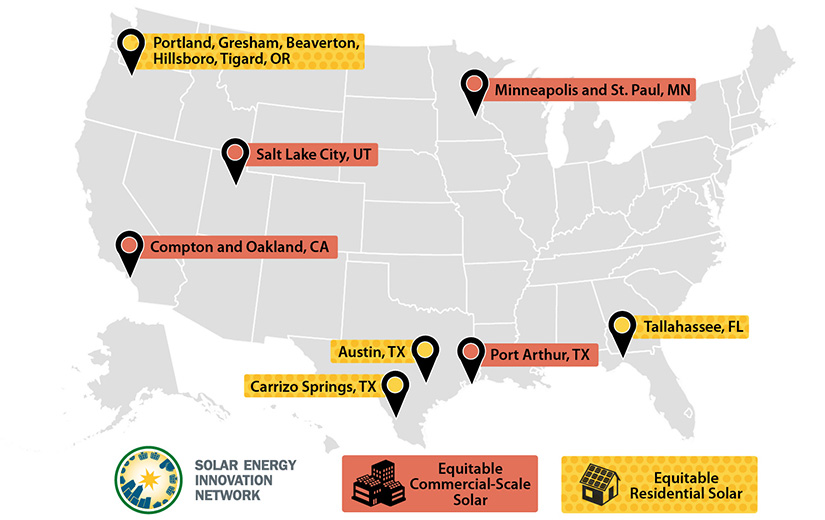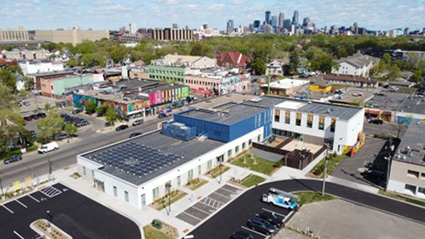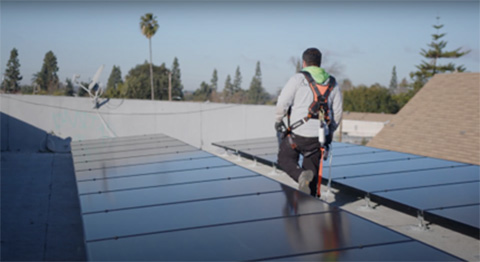These Innovative Approaches Harness the Benefits of Rooftop Solar Energy for Homes and Small Businesses
Multistakeholder Teams of Community-Based Organizations, Local Governments, Utilities, and Others Share Insights Gained Through the Solar Energy Innovation Network Round 3
The Solar Energy Innovation Network (SEIN) Round 3 brought together eight multistakeholder teams from various locations across the United States to develop new approaches to solar deployment, focusing on residential and commercial buildings in underserved communities.

Funded by the U.S. Department of Energy Solar Energy Technologies Office, SEIN enables communities to develop innovative solutions to overcome barriers to adopting distributed solar energy.
With SEIN Round 3 wrapping up, the teams' work is available to inform the efforts of all communities in the United States, helping them to bring the benefits of local solar electricity generation to their neighborhoods, small businesses, and residents. Resources published by the teams and NREL provide inspiration and project blueprints for solar adoption in other communities and are available for residential and commercial building applications.
Communities, organizations, decision makers, colleges, and other interested groups can use these materials to support local solar energy deployment. They can also request funding for technical assistance to implement their plans with Innovation at SCALE (Solar Community Assistance for Local Equity), a SEIN initiative. Requests for assistance open periodically throughout the year, and the next request window starts March 3.
"Most approaches to solar energy have been designed for early adopters—those with either the capital available up front to make a purchase or access to financing through loans or credit. Under many circumstances, it's a good deal for households or businesses to purchase electricity through local solar energy generation, but not for everyone—not yet," said Sara Farrar, who leads SEIN for the National Renewable Energy Laboratory (NREL). "SEIN Round 3 brought together multistakeholder teams—composed of utilities, local decision makers, and community-based organizations—to investigate ways to support underserved communities in determining whether going solar was right for them."
More Than Putting Panels on Roofs: Building a Plan for Resilient and Affordable Energy and Solar Workforce Development
During electricity outages caused by severe weather events or other emergencies, distributed solar and battery storage systems can provide resilient power, which helps communities withstand and recover from disasters. Low- to moderate-income (LMI) communities may be particularly vulnerable to economic and infrastructural damage caused by severe-weather-induced utility grid outages and disruptions.
One such LMI community is in Port Arthur, Texas. The SEIN project led by the Houston Advanced Research Center developed the Solar for Safety and Success: Resource Guide to give residents in Port Arthur greater access to the potential resilience benefits of solar energy and energy storage and further benefits like solar workforce development.
To support the Port Arthur team's goals, NREL engineers analyzed various community buildings to find optimal locations for battery energy storage systems—where solar panels, battery storage, and generators can increase the probability of maintaining power through a grid outage. Their analysis, Evaluating Utility Costs Savings and Resilience: A Case Study in Port Arthur, Texas, which weighs the potential economic benefits of incorporating energy storage against the cost of power outages, can be applied to other communities.
Community Needs Come First: A Successful Solar Plan Starts With Stakeholder Engagement
As the SEIN multistakeholder teams began their projects, they engaged with their target communities—from LMI residences to small business owners—to determine their energy needs and goals. This was a key factor in the teams' successes.
Solar Deployment for Small Businesses

The Minnesota Twin Cities team's Advancing Small Business Solar Equity: Final Technical Insights Report (on the Lake Street Council website) details their Solar Hub Network model for small businesses in historically underserved neighborhoods. Led by the Lake Street Council, the team used human-centered design to identify the barriers and gaps impeding widespread solar energy adoption among the members of three small business associations in the Twin Cities.
The Twin Cities team's approach can be implemented by other organizations looking to bring solar energy to small business communities.
NREL staff also collaborated with the Twin Cities team to produce a forthcoming economic analysis of various building types and financial models that would yield financial benefits for business owners in the represented neighborhoods.

Another team, led by the Salt Lake City Department of Sustainability, examined the value to small businesses of various utility-sponsored battery programs that would help these businesses increase energy resilience for themselves and the surrounding community. They also analyzed Utah's customer-owned battery program, Wattsmart—analysis which is available in a toolkit from the team (on the Utah Energy Hub website).
NREL's companion fact sheets—Financing Solar + Storage for Small Businesses in Underserved Communities and Utility Programs Supporting Customer-Sited Battery Storage: Program Design To Ensure Mutual Benefits—offer more analysis to support LMI small business access to solar energy.
As a SEIN partner, RMI developed a resource for small businesses and utilities—Collaborating With Utilities To Meet Underserved Community Needs: A Guide to Equitable Commercial Solar and Solar + Storage Deployment (on the RMI website). The report identifies challenges and successes of SEIN's Round 3 teams while providing guidance for other small businesses to unlock the benefits of utility programs that encourage and facilitate solar deployment.
Community Engagement for Solar Adoption in Residential Settings
The team from Tallahassee, Florida, led by ReThink Energy Florida, explored the energy burdens of three of their city's LMI neighborhoods. The team implemented a community engagement framework that focused on informing, consulting with, and collaborating with the community to consider how residents could benefit from solar energy opportunities. The team conducted field research to study both the barriers to solar deployment and identify solar-ready homes in three LMI Tallahassee neighborhoods.
The Austin, Texas-based team, led by Pecan Street and partners, similarly focused on increasing local solar knowledge. The team engaged with LMI neighborhoods in Austin's Eastern Crescent area to explore how rooftop solar energy could meet the community's energy resilience and affordability needs. The team identified community challenges, including lack of trust in solar companies and salespeople, confusing solar financing options, and unfair solar access and developed a guide for consumers to help them safely explore solar energy options.
The SEIN team led by Energy Trust of Oregon in Portland, Oregon, created the Solar Ambassadors pilot program, which was developed collaboratively by eight nonprofit organizations with the goal of raising awareness of rooftop solar energy among communities of color in the Portland area. Their guidebook includes definitions for novices to understand solar energy and advice for how to talk to solar contractors, along with a full Spanish translation. Check the SEIN publications database soon for this resource.
Navigating Funding Opportunities
Low-income households often face a high energy burden—a higher percentage of income going to energy bills—which could be alleviated through energy production from distributed solar. However, a common barrier to rooftop solar adoption for low-income households is the up-front cost.
The SEIN team led by the Texas Energy Poverty Research Institute (TEPRI) explored pathways to alleviate the up-front cost with a combination of local weatherization-agency incentives and utility rebates. By leveraging existing programs, the project demonstrated a path for LMI households in Carrizo Springs and Austin, Texas, to achieve lower electricity bills with no up-front cost. Their findings—including examples of outreach materials and project checklists for community-based organizations leading solar adoption—are included in the team's final report: New Pathways for Equitable Solar Adoption in Texas (on the TEPRI website). These outputs serve as a pilot demonstration for what may be possible by combining solar system installation funding from the federal Low Income Home Energy Assistance Program and Weatherization Assistance Program.

Houses of worship in LMI communities may also face financial barriers to the benefits of solar energy. The SEIN project team led by RE-volv focused on increasing solar adoption by houses of worship serving and led by people of color. RE-volv and multistakeholder partners identified federal tax incentives for houses of worship and other nonprofits as part of their work with SEIN (on the RE-volv website). The team also helped install a solar-plus-storage system at Watts-Willowbrook Church in Compton, California, which is now a place where the surrounding community can gather to cool off, charge phones, and store refrigerated medicines during electricity outages.
To help SEIN project teams and others understand how to leverage federal tax incentives with private or local government funding, NREL researchers developed the Screening Tool for Equitable Adoption and Deployment of Solar (STEADy Solar). This dataset combines publicly available information relevant to residential and commercial solar economics to support LMI communities in overcoming financial barriers to purchasing solar systems.
Take Advantage of Technical Assistance To Adapt SEIN Blueprints for Your Community: Innovation at SCALE
SEIN's Solar Community Assistance for Local Equity (Innovation at SCALE) builds on the success of SEIN projects by bringing these insights to new contexts through assistance tailored to each community.
Innovation at SCALE participants engage with subject matter experts and SEIN project leaders to identify and implement the insights and lessons from three rounds of SEIN projects that can be impactful in their communities.
For more information on how you can apply insights from previous SEIN projects in your community, check out the Innovation at SCALE webpage. Applications open on March 3, 2025. Subscribe to the SEIN newsletter to receive updates about this program directly to your inbox.
Contact Jibo Sanyal or Alex Kramer with questions about the Solar Energy Innovation Network.
This article has been updated to reflect an editorial change made after its original publication.
Last Updated May 28, 2025
